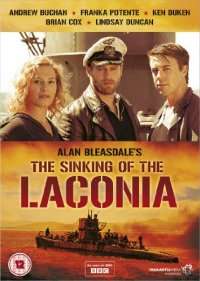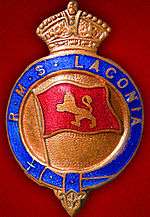The Sinking of the Laconia
| The Sinking of the Laconia | |
|---|---|
 UK DVD cover | |
| Genre | Drama |
| Written by | Alan Bleasdale |
| Directed by | Uwe Janson |
| Starring |
Andrew Buchan Brian Cox Ken Duken Lindsay Duncan Matthias Koeberlin Thomas Kretschmann Frederick Lau Morven Christie Franka Potente Ludovico Fremont |
| Country of origin |
United Kingdom Germany |
| Original language(s) | English & German |
| No. of episodes | 2x90 minutes |
| Production | |
| Running time | 180 minutes |
| Release | |
| Original network |
BBC2 Das Erste SWR Fernsehen |
| Original release | 6 January, BBC2, 21:00 [Part 1] – 7 January 2011, BBC2, 21:00 [Part 2] |
| External links | |
| Website | |
The Sinking of the Laconia is a two-part TV film, first aired on 6 and 7 January 2011 on BBC Two, about the Laconia incident; the sinking of the British ocean liner RMS Laconia during World War II by a German U-boat, which then, together with three other U-boats and an Italian submarine, rescued the passengers but was in turn attacked by an American bomber.
The film is a British-German co-production, written by Alan Bleasdale, directed by Uwe Janson, and with Andrew Buchan, Brian Cox, Ken Duken, Morven Christie, Lindsay Duncan, Thomas Kretschmann and Franka Potente in the leading roles.
Story

Six hundred miles from the coast of Africa, in September 1942, a German U-boat, U-156, sinks the British troopship Laconia which is en route from Cape Town to the United Kingdom.[lower-alpha 1]
When realising that there are POWs and civilians on board, and that they are facing certain death without rescue, U-boat Commander Werner Hartenstein (Duken) makes a decision which goes against the orders of German high command. The U-boat surfaces and Hartenstein instructs his men to save as many of the shipwrecked survivors as they can.[lower-alpha 2] Hartenstein also attempts to dive with all the survivors on board and, though this puts the submarine into a crash dive, control is regained and it resurfaces. He also has a Red Cross flag displayed and a message sent to the Allies to organise a rescue of the survivors. The Italian prisoners are taken off U-156 by another U-boat and an Italian submarine.[lower-alpha 3]
Sierra Leone had informed the Americans to look for Laconia survivors but not of the submarine's rescue efforts. Soon after the Americans' attack, U-156 resumes her hunting duties, leaving behind the lifeboats with the British survivors to be picked up by a Vichy naval surface ship sent by Karl Dönitz. While admiring Hartenstein's actions, Dönitz also reluctantly composes the Laconia Order to other U-boat commanders not to rescue survivors in future. The French ship arrives; one lifeboat leaves the others to make for the coast of west Africa, which it eventually reaches. One British merchant seaman is injured in the American attack and remains with U-156 until it reaches port, where he is taken into captivity. Dönitz awards Hartenstein the Ritterkreuz and offers him a desk job at naval command. Preferring to remain with his men, Hartenstein refuses it and a final on screen message reports U-156's later sinking with no survivors.
Production
The production is a cooperation of the British BBC with the German ARD Degeto and SWR Fernsehen, executed by TalkbackThames and Teamworx.[2][3] The idea to bring the story of the Laconia to screen was conceived in 2004 by Talkback Thames Head of Drama Johnathan Young.[4]
Full cast
RMS Laconia
- Andrew Buchan - Junior Third Officer Thomas Mortimer, RMS Laconia
- Franka Potente - Hilda Smith, passenger, RMS Laconia
- Lindsay Duncan - Elisabeth Fullwood, passenger, RMS Laconia
- Brian Cox - Captain Sharp, RMS Laconia
- David Butler - First Officer Steel, RMS Laconia
- Morven Christie - Laura Ferguson, passenger, RMS Laconia
- Jodi Balfour - Sarah Fullwood, passenger, RMS Laconia
- Nicholas Burns - Captain Benjamin Coutts, British Army
- Ciarán McMenamin - Declan McDermott, wine steward, RMS Laconia
- Lenny Wood - Billy Hardacre, trimmer, RMS Laconia
- Ben Crompton - Harry Townes, acting leading seaman, RMS Laconia
- Matthew Aubrey - Corporal William Williams, cook, British Army
- Ludovico Fremont - Di Giovanni, Italian POW
- Paul Hilton - Henry Bates, passenger, RMS Laconia
- Louise Barnes - Mary Bates, passenger, RMS Laconia
- Josef du Plessis - Anthony Bates, passenger, RMS Laconia
- Rebekah Nathan - Charlotte Bates, passenger, RMS Laconia
- Richard Firth - Quartermaster, RMS Laconia
- Tom Fairfoot - Wireless Operator, RMS Laconia
- Lawrence Joffe - Sergeant Rudzinski, Free Polish Army
U-156
- Ken Duken - Korvettenkapitän Werner Hartenstein, captain, U-156
- Jacob Matschenz - Oberleutnant zur See Mannesmann, first officer, U-156
- Matthias Koeberlin - Oberleutnant (Ing.) Rostau, chief engineer, U-156
- Oskar Brown - Waldemar, U-156
- Frederick Lau - Fiedler, wireless operator, U-156
- Jörg Malkow - Weber, wireless operator, U-156
- Stefan Rudolf - Remmert, U-156
- Hermanus Pieters - Dengler, U-156
Sierra Leone
- Danny Keogh - Captain Hathaway, Royal Navy
- James Alexander - Lieutenant Lincoln, Royal Navy
- Ian van der Heyden - Lieutenant Jackson, Royal Navy
U-boat command
- Thomas Kretschmann - Admiral Karl Dönitz, Commander of U-Boats
- Nikolai Kinski - Korvettenkapitän Walter Drexler, Dönitz's aide
Ascension Island
- Jannes Eiselen - Captain Robert C. Richardson III, USAAF
- Grant Swanby - Colonel Ronin, USAAF
- Darron Meyer - Harrower, pilot, USAAF Liberator
- Nicholas Pauling - Perlman, navigator, USAAF Liberator
- Charlie Keegan - Ches, gunner, USAAF Liberator
- Justin Shaw - Chuck Bannister, gunner, USAAF Liberator
- Marius Botha - Coleman, bombardier, USAAF Liberator
Other
- Simon Verhoeven - Korvettenkapitän Harro Schacht, captain, U-507
- Paul Savage - Egyptian Customs Officer
Follow-up programme
On 9 January 2011, BBC Two broadcast a half-hour documentary, The Sinking of the Laconia: Survivors' Stories, featuring testimonies from the actual survivors of the Laconia. Beginning 14 April 2012, Ovation television aired The Sinking of the Laconia in the United States.[5]
See also
Footnotes
- ↑ Laconia carries 1,800 Italian POWs, 80 British women and children, 103 Free Poles and 268 British soldiers guarding the prisoners, and a 136-man crew; in total 2,700 people.[1]
- ↑ U-156 crams 200 people on board the surfaced submarine, takes another 200 in tow in four lifeboats, and tries to give relief to the remaining shipwrecked who surround the U-boat in lifeboats and small rafts.[1]
- ↑ The submarine is correctly called the Comandante Cappellini, who actually participated in the rescue operations
References
- 1 2 Chapter about the Laconia Affair in Clay Blair's book The Hunted, 1942-1945 Retrieved 2011-01-08
- ↑ BBC Press Statement
- ↑ UFActs No. 89, December 2009
- ↑ The Independent 15 July 2010: "After 24 years, Alan Bleasdale is back on the BBC" Retrieved 2011-01-08
- ↑ http://Ovtn.tv/ma